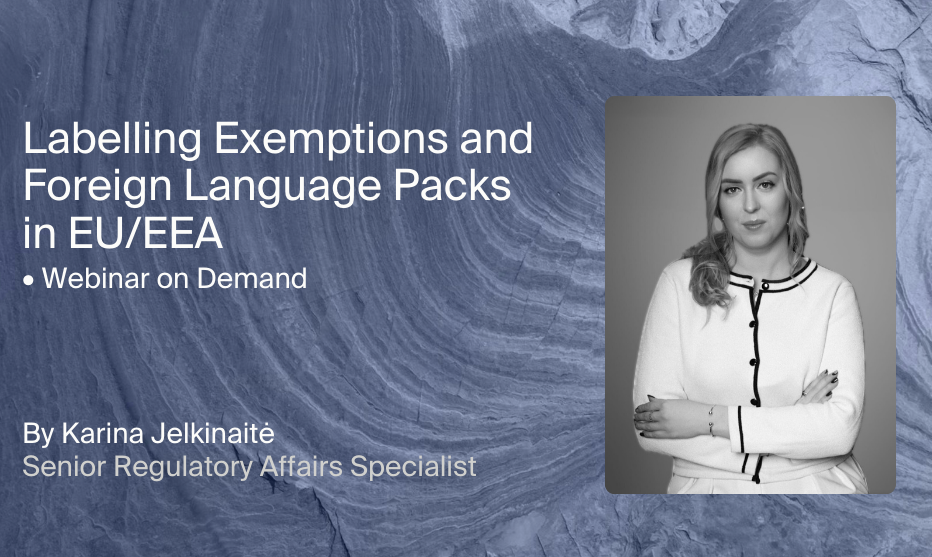
In our article “Navigating Labelling Exemptions: Strategies for Market Access (Part I),” we provided an overview of labelling exemptions at the European level. In this Part II, we will provide an outlook on labelling exemption regulation at the national level and share experiences and examples of some EU member states’ approaches.
Exemption Requests at the National Level
The provisions related to exemptions for orphan medicinal products remain the same, as per Article 63(1) of Directive 2001/83/EC: “In the case of certain orphan medicinal products, the particulars listed in Article 54 may, on reasoned request, appear in only one of the official languages of the Community.” Exemptions to orphan labelling at the national level differ between member states. Parts of an orphan medication label may be written in the official language of another EU member state, according to EU laws. Authorities can provide whole or partial exemptions from the requirement to translate the label and package leaflet, allowing a medicine to be supplied to the market in another EU member state language. MAHs must typically still supply the packaging leaflet in the local language. This can be done at the manufacturing site specified in the MA documentation or, under agreement with the competent authority, by another activity license holder for the manufacturing of medicinal products. Some countries, e.g., Italy, have the possibility for pharmacists to print patient leaflets, which is helpful in this case. Manufacturers can seek EU exemptions beginning with the initial marketing authorisation application and continuing until the medicinal product is on the market. The exemption is permanent, and there is no application fee.
Hospital Medicine to be Administered by Healthcare Professionals Only
With the common goal of improving patients’ lives through advances and improved care, pharmaceutical companies are constantly working closely with healthcare professionals. This long-standing and well-regulated connection is critical in the research and development of life-saving medicinal products, as well as their clinical application. Companies developing medicinal products that are not intended to be delivered directly to the patient, or where there are severe problems concerning the availability of the medicinal product, the competent authorities may, subject to measures they consider necessary to safeguard human health, grant an exemption to the obligation that certain particulars should appear on the labelling and in the package leaflet according to Directive 2008/AC, Article 63 (3). These include both medications that are being marketed but are temporarily out of stock, as well as those discontinued from selling but with an active license.
Exemption to the Obligation That Certain Particulars Should Appear on the Labelling (Outer and Immediate) and in the Package Leaflet:
- Requests for omission of particulars for medicinal products not intended to be delivered directly to patients or in case of severe availability problems related to the potential lack of authorised medicinal products or of medicinal products not being marketed should be submitted to and reviewed by the QRD group. In case the QRD group grants the exemption, it will only be applicable for the printed materials. All linguistic versions will contain the same information, and the elements to be omitted will appear grey-shaded in annexes labelling and package leaflet.
- In exceptional cases, requests for omission of particulars with the aim to create multilingual packages could be granted only for those Member States intending to use multilingual packages, e.g., where severe availability problems only exist in a limited number of Member States and when a consensus within the QRD group cannot be reached. Only the relevant linguistic version(s) will reflect the elements to be omitted in grey-shading in Annexes labelling and/or package leaflet. In case of disagreement between MSs sharing the same language, the linguistic version in question will contain clarification notes to indicate for which country this omission is applicable.
- The QRD recommendations on exemption requests should be adopted by the CHMP. The outcome of the QRD group decision will be reflected in the EPAR published on the EMA website (for requests made as part of a regulatory procedure) as well as in the QRD table of decisions.
Exemption to the Translation Obligation of Labelling (Outer and Immediate Labelling) and Package Leaflet:
- The request for a translation exemption should be handled at the national level, even if it concerns all Member States.
- The request may refer to all labelling components and package leaflet (full exemption) or to one of the labelling components and/or package leaflet (partial exemption).
- The relevant national decision will not be published on the EMA website: it will not be reflected in the assessment report, since the CHMP’s approval will not be required, and will not be included in the QRD table of decisions.
It is noteworthy that the national health system should be well considered when making a decision on whether a product can be considered a hospital product. Depending on who the payer is, there might be situations when a medicinal product, which may only be administered by HCP, is still dispensed to the patient in Pharmacy.
Example in the Netherlands
In the Netherlands, supply in foreign packaging can be used only as a last resort, (usually for hospital products). Usually, there is a preference for a repackaged product into Dutch.
Example in Italy
The competent authorities may exempt labels and package leaflets for specific medicinal products from the obligation that certain particulars shall appear and that the leaflet must be in the official language or languages of the Member State where the product is placed on the market, when the product is not intended to be delivered to the patient for self-administration.
Example in Spain
The packaging and labelling of medicinal products in Spain are regulated by Royal Decree 1345/2007. The Medicines Agency is in charge of approving the text and other features of packaging and labelling of medicinal products (including their amendments) authorised in Spain through the national procedure. According to Article 30, the texts will be presented in Spanish at least. In addition, they may also be written in other languages, provided that the same information is available in all languages. In such cases, the application shall be accompanied by the supporting documentation of the fidelity of the translation.
In the case of orphan medicinal products, the information provided for in the labelling may be drawn up on duly substantiated request in an official language of the European Union, in cases determined by the Spanish Agency for Medicines and Healthcare Products. Likewise, where the destination of the medicinal product is not the direct delivery to the patient, the Spanish Agency for Medicinal Products and Sanitary Products may dispense with the obligation to make certain information on the labelling and the package leaflet, as well as writing the prospectus in Spanish. Without prejudice to the foregoing, in the cases referred to above, the marketing authorisation holder shall make available to the Spanish Agency for Medicinal Products and Sanitary Products the information on the labelling and/or the package leaflet in Spanish, so that it can be made available to interested citizens and professionals.
Example in Belgium
In view of the quantity of information that has to be present on the packaging and the legal obligation to put everything in the three national languages, it is possible to ask for exemptions to the statutory information so that the legibility of the packaging can be improved and guaranteed. Some specific deviations are also possible for SPC and PIL. These derogation requests are always assessed case by case.
The possible exemptions are divided into four categories:
- Deviations from the primary and secondary (harmonised) packaging for which an exemption does not need to be requested and which are accepted irrespective of the size of the packaging.
- Deviations from the primary and secondary (harmonised) packaging which need to be requested and which are acceptable provided the lack of space can be proven.
- Deviations from the primary and secondary (harmonised) packaging for which an exemption needs to be requested.
- Deviations from the SPC and the leaflet for which an exemption must be requested.
Example in the Baltics (Estonia, Latvia, Lithuania)
In situations where the marketing authorisation holder is unable to ensure the availability of medicinal products with labelling information and package leaflet in the state language (including repacking of medicinal product), an exception can be made by distributing medicinal products in foreign packaging material. The medicinal product in the European Economic Area (EEA) language packaging intended to be distributed in the Baltics market must otherwise comply with the terms of the marketing authorisation issued, if medicinal products with the same active substance and of the same strength are not distributed in the local market (except the language of the package labelling). It is equally important to ensure the safe use of the medicinal products distributed in foreign language packaging. To apply for the exemption in the national language requirements, the marketing authorisation holder must send the State Agency of Medicines a signed notification to receive authorisation to distribute medicinal products in packaging of another member state of the EEA.
Each case is individually assessed, but the following information must accompany every application: the language of the package labelling, reasons for the medicinal product to be distributed in packaging of another member state of the EEA, and the number of packages to be exempted or the time limit intended for the exemption. The permit usually is issued within 7 working days and only after making sure that the medicinal product corresponds to the data and information of the registration documents of the medicinal product, except for the name of the medicinal product, the labelling of the package and the package leaflet, and after determining the necessary measures to protect public health so that the medicinal product is correctly identified and correctly administered. The permit is valid as long as the reasons for which it was issued continue, but no longer than one year from the date of issuance of the permit in Estonia and no longer than 6 months in Latvia and Lithuania.
It is equally important to ensure the safe use of the medicinal products distributed in foreign language packaging. For medicinal products intended to be delivered directly to patients, the state-language PIL has to be added to each package. It is also possible to over-sticker the packages of centrally authorised medicinal products, but the process of over-stickering must be done at the manufacturing site specified in the MA documentation and must be coordinated with the European Medicines Agency (EMA).
Conclusion
There are several possible pathways at European and local levels to support access to medicines for patients. EMA and local health authorities put joint efforts into simplifying pathways and reducing costs for Marketing Authorisation Holders to support investment in the development and supply of orphan and hospital medicines with low sales volumes. Global changes at the EU level like ePI (electronic patient information) will also have a significant role in simplifying the supply of foreign packs and still have all information available for patients and health professionals. You may find more information about ePI here.
Expert Support for Navigating Labeling Exemptions Across Countries
Navigating the intricate landscape of labelling exemptions across different countries can be a daunting task for many businesses. Understanding the nuances of each country’s regulations requires a level of expertise and experience that not all companies possess in-house. That’s where we come in. As subject matter experts in the field of pharmaceutical regulations, including labelling exemptions, we are here to guide you through this complex process. Whether you’re facing challenges at the European level or dealing with national-level exemptions, our team has the knowledge and experience to provide you with the support you need.
Don’t hesitate to reach out to us for assistance. Together, we can ensure that your medicinal products meet all regulatory requirements, facilitating smoother market access and ultimately contributing to the well-being of patients around the world.





